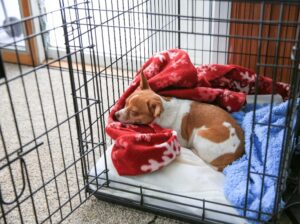-
Adopt
-
Veterinary Care
Services
Client Information
- What to Expect – Angell Boston
- Client Rights and Responsibilities
- Payments / Financial Assistance
- Pharmacy
- Client Policies
- Our Doctors
- Grief Support / Counseling
- Directions and Parking
- Helpful “How-to” Pet Care
Online Payments
Emergency: Boston
Emergency: Waltham
Poison Control Hotline
-
Programs & Resources
- Careers
-
Donate Now
 By Joel Kaye, DVM
By Joel Kaye, DVM ![]()
angell.org/generalmedicine
generalmedicine@angell.org
617-522-7282
Crate training your pet is a terrific investment in your pet’s future health and well-being.
Crate training your pet can help you with:
House Training: Helps your dog learn not to urinate inside.
Chew Training: Teaches your dog to chew legitimate toys.
Settling: Teaches your dog how to settle when alone or inactive.
Kenneling: Helps to increase your dog’s comfort level in the crate as your pet may need to stay in a crate during travel or hospital visits.
- A crate should be large enough for your dog to stand up and turn around, but no larger. Otherwise they may be tempted to eliminate in one corner and sleep in the other
- A fluffy blanket or crate pad to increase the crate’s comfort
- High value treats, toys and a Kong toy stuffed with treats or food
The crate should be in an area of high traffic such as a kitchen or family room, so the pet feels like he or she belongs.
Training: Getting your pet used to a crate, is a gradual process that takes time. You cannot just put them in and hope they will adjust. This can create more trauma and make it even more difficult. The goal is to make your pet feel good about going in the crate.
Step 1: Start crate training the moment you get home with your new pet. Place a few strategic treats in the crate for your pet to find. Do not point them out, just let them discover the treats on their own.
Feed your pet their meals in the crate using the Kong toy and stuffing it with food. Secure the Kong toy to the side of the cage to make it easier for your pet to access the food. You will want to continue feeding meals in the crate until they are comfortable being crated.
Step 2: Train your pet to enter the crate on command. Use a command such as “Into the crate,” or “Into your bed” followed by a treat being thrown in the crate. Praise your pet loudly and enthusiastically as they go in to eat the treat. Repeat this many times. Once they have gotten the hang of this, try switching the order around by saying the same commands but waiting until they go in to offer the treat. If they do not go in, they do not get the treat. After a couple of tries, if they refuse, you can end this session and try again later. As they start to master the behavior, increase the number of treats as a reward. Once they have mastered this you can move on to the next step.
Step 3: Give the command to enter the crate. This time when they enter the crate, shut the door behind them and feed them copious treats through the bars for a minute or so and then open the door. Repeat this several times. Once they get the hang of this practice walking around the crate or around the room while the pet is locked inside occasionally throw in treats. After a few minutes of this open the crate and let them out. Once they have mastered this you can start increasing the duration of time in the crate.
Step 4: To increase the duration of time requires you offer a very high value treat to your dog. A helpful way to increase duration in the crate is to stuff a Kong with their favorite treat (yes even peanut butter), place it next to you on the couch or floor and tell the pet to enter the crate. Once the pet enters the crate offer the Kong and close the door. Practice leaving the room a few times, but come back in a minute or so. Do your best to ignore any tantrums. Once the pet is quiet and settled it is okay to open the door. Do not open the door if the pet is pawing the door, whining or barking. When they do exit, try to get them to sit first and calmly exit.
You will need to spend a few days on this step. Practice leaving the pet in the crate while you are home. Ignore any noises and provide interesting safe toys to occupy them.
Step 5: Leaving your pet home alone in the house. This is a very gradual process as well. In the first session, leave the house many times for very short periods of time of 1 to 10 seconds. Over the next few sessions gradually extend the time that you are gone. Go from 1 to 5 to 10 minutes etc., gradually extending the time you’re gone. Vary your time gone to mix things up.
A very key portion of this process is to leave and return without any fanfare. When leaving the house try to mix up some of the cues that indicate that you are leaving such as picking up your keys, purse, or backpack. Try picking these up randomly at times that you are not leaving to desensitize your pet.
More Tips for Success
It is helpful to tire out your dog with vigorous exercise and training, especially before longer absences.
Most importantly do not use the crate as a punishment.
Music or sound machines with soothing sounds may make your dog more comfortable in the crate.
Thanks to modern technology, an excellent way to monitor your pet’s comfort level while your away is to install a WebCam to monitor your pet for signs of anxiety or discomfort.
I am often questioned about how long it is safe to leave your pet alone when it is young. Typically the answer is approximately one hour for every month of age. Especially when younger try not to leave your pet confined to a crate for longer than 3 to 4 hours at a time, except for bedtime. Keep in mind, especially with young puppies, they need to be taken outside often to eliminate.
If you put your pet in a crate and he bites the wiring or digs at the floor for excessive periods of time, at that point it is not recommended to confine them in a crate. This can be a symptom of something called separation anxiety that is best handled by a veterinary behaviorist.
